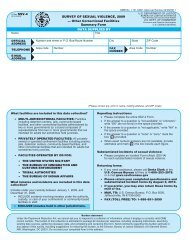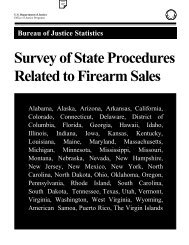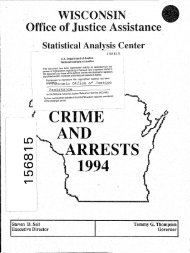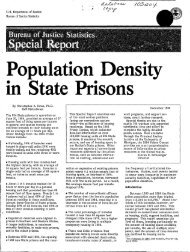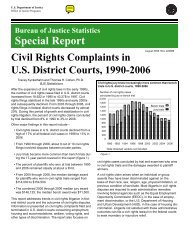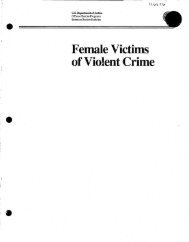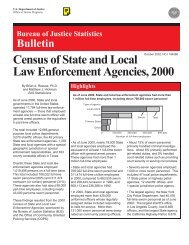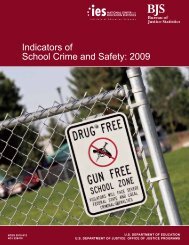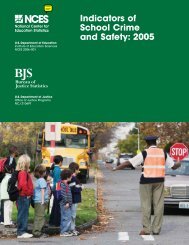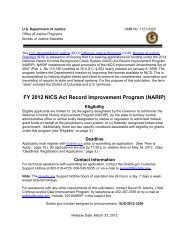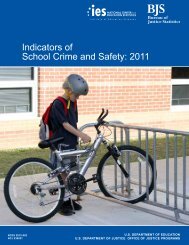<strong>Sourcebook</strong> <strong>of</strong> <strong>Criminal</strong> <strong>Justice</strong> <strong>Statistics</strong> <strong>1983</strong>be uniformly compiled in terms <strong>of</strong> a single classification <strong>of</strong> <strong>of</strong>fenses.The definitions <strong>of</strong> the Part II <strong>of</strong>fenses that follow include some <strong>of</strong> the<strong>of</strong>fense titles described in local or State law. The inclusion <strong>of</strong> thesetitles is intended to serve as descriptive data to aid in determiningwhat <strong>of</strong>fenses should be included or excluded in each classification.9. Other assaults--Assaults and attempted assaults where noweapon was used or that did not result in serious or aggravated injuryto the victim are included as other assaults.Examples <strong>of</strong> local jurisdiction <strong>of</strong>fense titles that would beincluded in "other assaults" are: (a) simple assault; (b) minor assault.(c) assault and battery; (d) injury by culpable negligence; (e) resistingor obstructing an <strong>of</strong>ficer; (f) intimidation; (g) coercion; (h) hazing. (j)attempts to commit above.'10. Forgery and counterfeiting--In the majority <strong>of</strong> States,forgery and c:ounterfeiting are treated as allied <strong>of</strong>fenses. In this classare placed all <strong>of</strong>fenses dealing with the making, altering, uttering, orpossessing, with intent to defraud, anything false in the semblance <strong>of</strong>that which is true.Included are: (a) altering or forging public and other records'(b) making, altering, forging, or counterfeiting bills, notes, drafts:tickets, checks, credit cards, etc.; (c) forging wi lis, deeds, notes,bonds, seals, trademarks, etc.; (d) counterfeiting coins, plates,banknotes, checks, etc.; (e) possessing or uttering forged orcounterfeited instruments; (f) erasures; (g) signing the name <strong>of</strong> anotheror fictit.ious person with intent to defraud; (h) using forged labels; (I)possession, manufacture, etc., <strong>of</strong> counterfeiting apparatus; (j) sellinggoads with altered, forged, or counterfeited trademarks; (k) allattempts to commit the above.II. Fraud--Fraud is defined as fraudulent conversion andobtaining money or property by false pretenses. Included are bodchecks, confidence gomes, etc., excellt forgeries and counterfeiting.12. Embezzlement--Embezzlement is defined asmisappropriation or misapplication <strong>of</strong> money or property entrusted toone's core, custody, or control.13. Stolen propertYl buying, receiving, possessing--Includedin this closs ore all <strong>of</strong>fenses <strong>of</strong> buying, receiving, and possessing stolenproperty, as well as all attempts to commit any <strong>of</strong> these <strong>of</strong>fenses.14. Vandalism--Vandalism consists <strong>of</strong> the willful or maliciousdestruction, injury, disfigurement, or defacement <strong>of</strong> any public orprivate property, real or personal, without consent <strong>of</strong> the owner orperson having custody or control, by cutting, tearing, breaking,marking, pointing, drawing, covering with filth, or any such means asmoy be specified by local low. This <strong>of</strong>fense covers a wide range <strong>of</strong>malicious behavior directed at property such as: cutting :luto tiresdrawing obscene pictures on public restroom walls, smashing windows:destroying school records, tipping over gravestones, defacing librarybooks, etc. All arrests for the above, including attempts, are counted.15. Weapons; carrying, possessing, etc.--This closs deals withweapon <strong>of</strong>fenses, regulatory in nature, such as: (0) monufacture, sale,or possession <strong>of</strong> deadly weapons; (b) carrying deadly weapons,conc~al~d or openly; (c) using, manufacturing, etc., silencers; (d)furnishing deadly weapons to minors; (e) aliens possessing deadlyweapons; (f) all attempts to commit any <strong>of</strong> the above.16. Prostitution and commercialized vice--Included in thisclass are the sex <strong>of</strong>fenses <strong>of</strong> a commercialized nature, such as: (0)prostitution; (b) keeping a bawdy house, disorderly house, or house <strong>of</strong>ill fane; (c) pandering, procuring, transporting, or detaining women forimmorol purposes, etc.; (d) all attempts to commit any <strong>of</strong> the above.17. Sex <strong>of</strong>fenses (except forcible rape and prostitution andcomnercialized vice)--Included are <strong>of</strong>fenses against chastity, commondecency, morals, ond the like, such as: (0) adultery and fornication'(b) buggery; (c) incest; (d) indecent exposure; (e) indecent liberties!(f) intercourse with an insane, epileptic, or venereally diseased person!(g) seduction; (h) sodomy or crime against nature; (j) statutory rap~(no force); (j) all attempts to commit any <strong>of</strong> the above.18. Drug abuse violations--Drug abuse violation arrests arerequ~s:~d on the basis <strong>of</strong> the. narcotics used. The followingsubdiVISions are used: (0) opIUm or cocaine and their derivatives(morphine, heroin, codeine); (b) marihuana; (0) synthetic narcotics-manufactured narcotics that can cause true drug addiction (demerol,methadones); (d) dangerous nonnarcotic drugs (barbituratesbenzedrine).'Included are all arrests for violations <strong>of</strong> State and local lawsspecifically those relating to the unlawful possession, sale, use:growing, manufacturing, and making <strong>of</strong> n'Jrcotic drugs.19. Gombling--AII charges that relate to promoting, permitting,or engaging in gambling are included in this category. To provide amore refined collection <strong>of</strong> gambling arrests, the following breakdown <strong>of</strong>gambling arrests is made: (0) bookmaking (horse and sport book); (b)numbers and lottery; (c) all other.20. Offenses against the family and children--I ncluded areall charges <strong>of</strong> nonsupport and neglect or abuse <strong>of</strong> family and children,such as: (0) desertion, abandonment, or nonsupport <strong>of</strong> wife or child; (b)neglect or abuse <strong>of</strong> child (if the injury is serious, it is counted asaggravated assault); (c) nonpayment <strong>of</strong> alimony; (d) all attempts tocommit any <strong>of</strong> the above.21. Driving under the influence--This closs is limited to thedriving or operating af any vehicle or common carrier while drunk orunder the influence <strong>of</strong> liquor or narcotics. Included are: (0) operatinga motor vehicle while intOXicated, (b) operoting on engine, train,streetcar, boat, etc., while intoxicated.22. Liquor laws--With the exception <strong>of</strong> "drunkenness" (closs 23)and "driving under the influence" (class 21), liquor low violations, Stateor local, are placed in this class. Federal violations are not included.Included are: (a) manufacturp., sale, transporting, furnishing,possessing, etc.; intoxicating liquor; (b) maintaining unlawful drinkingplaces; (:) advertising and soliciting orders for intoxicating liquor; (d)bootlegging; (e) operating still; (0 furnishing liquor to a minor orintemperate person; (g) using a vehicle for illegal transportation <strong>of</strong>liquor; (h) drinking on train or public conveyance; (j) all attempts tacommit any <strong>of</strong> the above.23. Drunkenness--Included in this class are all <strong>of</strong>fenses <strong>of</strong>drunkenness or intoxication, with the exception <strong>of</strong> "driving under theinfluenc.e" (class 21). Such things as drunkenness, drunk and disorderly,c:omnon or habitual drunkard, and intoxication are counted.24. Disorderly conduct--In this closs are placed all charges <strong>of</strong>c;ommitting a breach <strong>of</strong> the peace. Included are: (0) affray; (b)unlawful assembly; (c) disturbing the peace; (d) disturbing meetings;i(e) disorderly conduct in State institutions, at court, at fairs, on'trains! or public conveyances, etc.; (f) prize fights; (g) blasphemy,pr<strong>of</strong>anity, and ob.ccme language; (h) desecrating flog; (j) refusing toIJssist on <strong>of</strong>ficer; (j) all attempts to commit any <strong>of</strong> the above.25. Vagrancy--Persons prosecuted on the charge <strong>of</strong> being a'''suspicious character or person, etc." are included in this closs. Itincludes: (a) vagrancy; (b) begging; (c) loitering (persons 18 and,alded; (d) vagabondage.26. All other <strong>of</strong>fenses--Included in this closs are all otherState or local <strong>of</strong>fenses not included in classes I to 25, such as: (a)'Jdmitting minors to improper places; (b) obduction and compelling tomarry; (e) abortion (death <strong>of</strong> on expectant mother, resulting from'Jbortion. is a homicide, closs 10); (d) bigamy and polygamy; (e)blclckmail and extortion; (f) bribery; (g) combination in restraint <strong>of</strong>trade, trusts, or monopolies; (h) contempt <strong>of</strong> court; (j) crimina'Jnarchlsm; (j) criminal syndicalism; (k) discrimination, unfair.~ompetition; (J) kidnaping; (m) marriage within prohibited degrees; (n)IJffenses contributing to juvenile d.elinquency (except as provided for in,:iclSses I to 28 inclusive) such as. employment <strong>of</strong> children in immoralvocations or practices, admitting minors to improper places, etc.· (a)perjury and subornation <strong>of</strong> perj". y; (p) possession, repair. manufacture,C!t·c., Clf burglar's tools; (q) possession or sale <strong>of</strong> obscene literature,pictures, etc.; (r) public nuisances; (s) riot and rout; (t) trespass' (u)unlawfully bringing weapons into prisons or hospifals' (v) unlaw'fullybringing drugs or liquor into State prisons, hospitals, etc. or furnishing10 convicts(. (w) unlawful disinterment <strong>of</strong> the dead and violation <strong>of</strong>!~pul!ure; x) unlawful use, possession, etc., <strong>of</strong> explosives; (y)I'l()lat~ons <strong>of</strong> State regulatory lows and muniCipal ordinances (this doesrot include those <strong>of</strong>fenses or regulations that belong in the abovecJ,~ssles); (z) violation <strong>of</strong> quarantine; (00) all <strong>of</strong>fenses not otherwiseclclSsified; (ab) all attempts to commit any <strong>of</strong> the above.27. Suspicion--Although "suspicion" is not an <strong>of</strong>fense, it is thegr,oun,d for many arrests in those Jurisdictions where the law permits.After examination by the police, the prisoner is either formally charged,or released. Those formally charged are entered in one· <strong>of</strong> the Part I orII oHense classes. This closs is limited to "suspicion" arrests whereI:~~rsons arrested are released by the police.28. Curfew and loitering laws--(juveniles)--i~1I arrests madefor 'Iiolation <strong>of</strong> local curfew or loitering ordinances where such laws(~lIist are counted.29. Runaway--{juveniles)--lncluded in this category arenpprehensions <strong>of</strong> runaways for protective custody as defined by localS.t'ltute. The jurisdiction from which the juvenile runs away countscu·rests <strong>of</strong> juveniles made by other jurisdictions.1
,-<strong>Sourcebook</strong> <strong>of</strong> <strong>Criminal</strong> <strong>Justice</strong> Stotistics <strong>1983</strong>an <strong>of</strong>fense) Is alleged or demonstrated to have occurred while his/herage was belllW the statutory limit <strong>of</strong> original jurisdiction <strong>of</strong> a juvenilecourt.Long-term focility--A correctional, as opposed to a detentionfacility. Includes training schools; ranches, forestry camps, and farms;and halfway houses and group homes.Nonpayroll staff--Full-time or part-time personnel not on thepayroll <strong>of</strong> the ~eporting facilit~. Includes individuals paid by a parentag~ncy or service who are assigned to the juvenile facility, personnelpaid under Conlr'lctual agreements or Federo! grcnts, and ;:;oiiegeI nterns. Excludes conmunity volunteers in 1971 when they were notcounted, and. in 1975, whe.n they were counted ds a separate group.C?i>eratlonal expendltures--Grass salaries and wages, plus otheroperating expenses.Payroll staff--Full-time and part-time personnel on the payroll<strong>of</strong> the reporting facility.Person in need <strong>of</strong> supervision (PINS)--Detention status <strong>of</strong> ajuvenile declared by a juvenile COl'rt to be in need <strong>of</strong> supervision.Encompasses those known variously as child in need <strong>of</strong> supervision(CHINS), juvenile in need <strong>of</strong> supervision (JINS), and minor in need <strong>of</strong>supervision (MINS), as well those designated as unruly unmanageableor incorrigible under special statutes for status <strong>of</strong>fende:s. All PINS ar~not stat~s <strong>of</strong>fenders, and all status <strong>of</strong>fenders are not PINS. Even inStates With status <strong>of</strong>fender statutes, juveniles with previous <strong>of</strong>fensescan be adjudicated delinquent for status <strong>of</strong>fenses. Conversely a judgecan declare. a jUvenile to be a person in need <strong>of</strong> supervisi~n for afelony or misdemeanor., Private focility--A juvenile detention or correctional facilitysubject to governmental licensing, but under the direct administrativeand oper.ational control <strong>of</strong> pri.vate enterprise; typically receivessubstantial governmental funding, in addition to support by privatesources.Public faciJity--A juvenile detention or correctional facilityunder the direct administrative r)'1d operational control <strong>of</strong> a State orlocal government.,Ranch, forestry camp, and farm--A long-term facility forpersons whose behavior does not necessitate the strict confinement <strong>of</strong> atraining school, <strong>of</strong>ten allowing them greater contact with theconmunity.Reception or diagnostic center--A short-term facility thotscreen~ person~ .conmltted by courts and assigns them to appropriatecorrectional facilities.Resident--A person, jUvenile or nanjuvenile, held In ajuvenile detention or correctional facility... Shelter--A shc;>r.t-t~rm facility that provides telTlf'Qrory careslm~lar to thet <strong>of</strong> d deTention center, but In a physically unrestrictingenvironment.Short-term faciJity--A detention, as opposed to a correctionalfc;>cility: Includes detention centers, shelters, and reception 0;diagnostic centers.Status <strong>of</strong>fense--An act or conduct that is declared by statute tobe on <strong>of</strong>fense, but cnly when conmltted or engaged In by a juvenile'.lnd that can .be odjudlcated only by a juvenile court. Typical statu~<strong>of</strong>fenses are Violation <strong>of</strong> curfew, running away from home truancypossession <strong>of</strong> alcoholic beverages, ond leading an Immoral 'life Bothadjudi~a!ed delinquents and juveniles declared to be persons in ~eed <strong>of</strong>supervIsion can be status <strong>of</strong>fenders.Training school--A long-term specialized type <strong>of</strong> facility thatprovide:; strict confinement for its residents.V",luntary .adm!ssion--A type <strong>of</strong> admission in which a juvenilevoluntarily canmlts hImself/herself to a fccillty without being adjudgedby a court to be delinquent or In need <strong>of</strong> supervision. The JUVenilemoy bt; referred to the facility for treatment by parents, court, schoolor SOCial agency.'Youthful <strong>of</strong>fender--A person, adjudicated In criminal court whomaY.b.e above the s~atytory age limit for jUveniles but bel~w aspeCified upper age limit, for whom special correctionol conmitmentsond spec!al record-:sealing procedures ore made avoiloble by statute.The speCial correctional conmltment may be to a juvenile facility to aspeci?1 section <strong>of</strong> on adult facility, or to 0 separate facility fa~ theconfinement <strong>of</strong> persons between the age limits specified In theparticular statute. Such provisions exist In Federal low and In the lows<strong>of</strong> several States.APPENDIX I,Survey <strong>of</strong> Delinquency Prevention Programs-Survey methodologyNJTE: The follOWing Information has been provided by the Notional Center for the Assessment <strong>of</strong>Delinquent Behavior and Its Prevention, Center for Low and <strong>Justice</strong>, University <strong>of</strong> Washington,Seattle, Washington.Identification <strong>of</strong> delinquency prevention programsIn 1979, the Notional Center for the Assessment <strong>of</strong> DelinquentBehavior and Its Prevention, Center for Low and <strong>Justice</strong>, UniVersity <strong>of</strong>Washington, initiated a notional survey in search <strong>of</strong> programs whoseactivities qualified as primary or secondary delinquency prevention.Primary prevention was def1'wd as modifying conditions in the physicaland social environment that lead to crime. Secondary prevention wasdefined as the early identification and intervention in the lives <strong>of</strong>youths in criminogenic circumstances. The focus was on youths beforedelinquent acts hod been conmitted or detected, generally before theycome in contact with law enforcement agencies. To identify a broadrepresentation <strong>of</strong> such p·ograms, a questionnaire was mai led to 898public funding, policy, and planning ager,cies <strong>of</strong> the Federal Governmentand all 50 States and Puerto Rico; to private foundations and agencies(such as the United Way); and to local social service agencies in 261U.S. cities. The following sources were used to generate the list <strong>of</strong>sampled agencies and organizations: The Foundation Directory, TheFoundation Grants Index, the Encyclopedia <strong>of</strong> Associations, TheAnnual Register <strong>of</strong> Grant Support, The Catalogue <strong>of</strong> FederalDomestic Assistance, The Government Organization Manual, andThe State Information Book. Any foundation or agency which mightprovide funding for delinquency prevention was included. Agenciesresponsible for social services, youth programs, 1('" enforcement,recreation, education, and labor were surveyed. The director <strong>of</strong> eachsurveyed organization was asked to nominate three programs he or sheviewed as the most promising or effective for preventing delinquencybefore youths become Involved with the low. A total <strong>of</strong> 875 programswere identified In this way. The principal administrator <strong>of</strong> each <strong>of</strong> theidentified programs was then surveyed using a second questionnaire.Sixty-two percent (540) <strong>of</strong> the 875 surveyed programs ultimatelyreturned completed questionnaires. Respondents inclUded a brood crasssection <strong>of</strong> youth-focused programs. Schools, various components <strong>of</strong> thecriminal justice system, mental health centers, youth service bureausand other organizations <strong>of</strong>fering a brood range <strong>of</strong> services wererepresented.In 1981, essentially the same procedures were followed in oneffort to identify addltlanal delinquency prevention programs. Thesources <strong>of</strong> progrom nominations were expanded to Include pr<strong>of</strong>essionalsworking In the area <strong>of</strong> delinquency prevention, program evaluators,academicians, and a search <strong>of</strong> research journals and newsletters.Nominators were asked for the names <strong>of</strong> promising delinquencyprevention programs without specifying that the programs shouldconcentrate on primary and secondary prevention. In addition, thenominators were not restricted to listing a maximum <strong>of</strong> three programs.After removing the names <strong>of</strong> programs which hod responded to the 197';1survey, 686 additional programs were identified. Surveys were sent tothe principal administrators <strong>of</strong> these programs. Ferty percent (275)returned completed questionnaires which were added to the data bose.SampleWhile the emphasis in the 1979 survey hod been on programsinvolved in primary and secondary delinquency prevention, a number <strong>of</strong>the nominators included programs which dealt with youths after theybecome involved with low enforcernent agencies (programs working topercent recidivism, i.e., terti(lry delinquency prevention). A number <strong>of</strong>the nominated programs were also found to be involved in all threelevels <strong>of</strong> prevention from primary to tertiary. These programs wereincluded in the survey and the data bose. The 1981 survey did notrestrict the nominators to primary or secondary prevention programs.The programs which responded to both surve';3 also varied in the targetages <strong>of</strong> their client populations, ranging from chilnren through adUltswho were <strong>of</strong>ten the parents <strong>of</strong> younger clients, protessionals in the lield<strong>of</strong> delinquency prevention, low enforcement personnel, or teachers. Inthe data presented here, programs exclusively targeting adults and onlyproviding services such as pareflfing training, delinquency preventioninformation, or other CJdult focused services were excluded. Inaddition, a Variety <strong>of</strong> organizational levels were represented by theprograms responding to the surveys. Programs which do not providedirect services to youths, acting, for instance, solely as servicebrokers, information and referral services, or program networkcoordinators were excluded from these data. These excluilionsestablished a data set for the information prllvlded here that includes494 programs from the 1979 survey and 254 programs from the 1981survey (91.8 percent <strong>of</strong> the 815 programs In the data bose).The surveyThe surveys were divided into two parts. The first port solicitedInformation an the program itself, Including geographical area served,target popUlation, organizational structure, st<strong>of</strong>f composition, services<strong>of</strong>fered, progrom budget, funding sources, and evaluation Information. Asecond section asked the administrator <strong>of</strong> the program to respond to aset <strong>of</strong> Likert-scaled propositions on causes <strong>of</strong> delinquency and methodsfor preventing It, based on seven mojor perspectiVes on the causes <strong>of</strong>juvenile delinquency. The data presented here are drown from the firstpart <strong>of</strong> the survey.Service codingThe programs responding to the surveys provided a wide variety<strong>of</strong> services, each program, typically, providing mare than one type <strong>of</strong>service. Services were identified and coded through content analysis <strong>of</strong>the returned questionnaires, descriptive literature provided by theprogram, interviews with some program personnel, and programevaluations, when these could be obtained. A maximum <strong>of</strong> eight <strong>of</strong>each program's mojo" services could be included in the data bose. Asubset consisting <strong>of</strong> 54 <strong>of</strong> these services provides the basis for some <strong>of</strong>the data presented here.644645
- Page 1 and 2:
u.s. Department of JusticeBureau of
- Page 3 and 4:
________ n~'·••SOURCEBOOKOF CR
- Page 5 and 6:
Sourcebook of Criminal Justice Stat
- Page 7 and 8:
Figure B An overview of detelnclude
- Page 9 and 10:
--------- - --Svurcebook of Crimina
- Page 11 and 12:
- - .. "-- - ~------~ ------------C
- Page 13 and 14:
Figure3.12 Estimated rate (per 100,
- Page 15 and 16:
TableFig. 2.6 Respondents taking pr
- Page 17 and 18:
Sourcebook of Criminal Justice Stat
- Page 19 and 20:
---------- - -- ~------------------
- Page 21 and 22:
- ...... - ~r---~---------~--------
- Page 24 and 25:
------------- - ~------~-----~-----
- Page 26 and 27:
Sourcebook of Criminal Justice Stat
- Page 28 and 29:
--------- -' -- - -'-- ----~-------
- Page 30 and 31:
---- -- --~------~ ---rl.Sourcebook
- Page 32 and 33:
~~---------- ---~----------~-------
- Page 34 and 35:
-------------- - ---~---~--------~-
- Page 36 and 37:
~~~~~~~---- - -- -Sourcebook of Cri
- Page 38 and 39:
----.... ....--.-. ~"'-.~Sourcebook
- Page 40 and 41:
(Sourcebook of Criminal Justice Sta
- Page 42 and 43:
-----~---------------------.-'-----
- Page 44 and 45:
Table 1.13 Number and rateOct. 31,
- Page 46 and 47:
~-~- ~-...--~ -- ~ ---,~-------. -.
- Page 48 and 49:
-- ..... -,-.--..-... ~~----r; __ '
- Page 50 and 51:
---..0lIl, - -~,..--- -- - - ----~-
- Page 52 and 53:
-----------------------------------
- Page 54 and 55:
.~------~--------------------------
- Page 56 and 57:
"Sourcebook of Criminal Justice Sta
- Page 58 and 59:
------------ - -- -"\I'Sourcebook o
- Page 60 and 61:
Sourcebook of Criminal Justice Stat
- Page 62 and 63:
Sourcebook of Criminal Justice Stat
- Page 65 and 66:
---- ~------~--~- -..---Sourcebook
- Page 67 and 68:
Sourcebook of Criminal Justice Stat
- Page 69 and 70:
.~f'ISourcebook of Criminal Justice
- Page 71 and 72:
Characteristics of the Criminal Jus
- Page 73 and 74:
f'Sourcebook of Criminal Justice St
- Page 75 and 76:
--'~--~---------------_..."'.".,..,
- Page 77 and 78:
'Sourcebook of Criminal Justice Sta
- Page 79 and 80:
------ ~---~-----~-----~Sourcebook
- Page 81 and 82:
-----------~-~---~-------Sourcebook
- Page 83 and 84:
-----~---~~~. -'""".-=-./}Character
- Page 85 and 86:
--------------------Sourcebook of C
- Page 87 and 88:
-----------------------------------
- Page 89 and 90:
[!r-·ISourcebook of Criminal Justi
- Page 91 and 92:
- _. - -------~--...;--~"-"----- --
- Page 93 and 94:
.~. ---..ot--~.....--- -- ~------_.
- Page 95 and 96:
Sourcebook of Criminal Justice Stat
- Page 97 and 98:
--""'1,- ~,.--- --_'M~II!tlT'-~'r.
- Page 99 and 100:
- -~--~--~-~~-------~----------Tabl
- Page 101 and 102:
~~--~~--~-----~ ----Sourcebook of C
- Page 103 and 104:
~-~-------------------------_--____
- Page 105 and 106:
------------Sourcebook of Criminal
- Page 107 and 108:
Sourcebook of Criminal Justice Stat
- Page 109 and 110:
Characteristics of the Criminal Jus
- Page 111 and 112:
------- -- - -- -Sourcebook of Crim
- Page 113 and 114:
"Sourcebook of Criminal Justice Sta
- Page 115 and 116:
Sourcebook of Criminal Justice Stat
- Page 117 and 118:
------"'--~ ,'~- =--Sourcebook of C
- Page 119 and 120:
Sourcebook of Criminal Justice S;at
- Page 121 and 122:
,,iSourcebook of Criminal Justice S
- Page 123 and 124:
Source: George H. Gallup, The Gallu
- Page 125 and 126:
----~------~~--~----------~--------
- Page 127 and 128:
Sourcebook of Criminal Justice Stat
- Page 129 and 130:
--------------Sourcebook of Crimina
- Page 131 and 132:
--~-~~~~---------'---Public Attitud
- Page 133 and 134:
---------------------Sourcebook of
- Page 135 and 136:
-----------------------------------
- Page 137 and 138:
----------- --~-_.------~---t]Sourc
- Page 139 and 140:
Sourcebook of Criminal Justice Stat
- Page 141 and 142:
234Sourcebook of Criminal Justice S
- Page 143 and 144:
Sourcebook of Criminal Justice Stat
- Page 145 and 146:
~---.-.-.~~~ .. ~.Sourcebook of Cri
- Page 147 and 148:
,~--------~---------------~--------
- Page 149 and 150:
-~---------i': 1r\ jI~1 Public Atti
- Page 151 and 152:
--~---------------~----------Source
- Page 153 and 154:
~-~ - -'--~-------~----~~----------
- Page 155 and 156:
~-~- ~-----------------------------
- Page 157 and 158:
· -.Figure 2.14 Attitudes toward t
- Page 159 and 160:
Sourcebook of Criminal Justice Stat
- Page 161 and 162:
Sourcebook of Criminal Justice Stat
- Page 163 and 164:
--"'" - -~--..--- -Sourcebook of Cr
- Page 166 and 167:
.,.----------- - --" ,,jSourcebook
- Page 168 and 169:
~---~----~---" '--Sourcebook of Cri
- Page 170 and 171:
Sourcebook of Criminal Justice Stat
- Page 172 and 173:
....... ,-"'-~--... ~.Sourcebook of
- Page 174 and 175:
-- ..... --~.....-- -- -~ --'\,j--S
- Page 176 and 177:
"~Sourcebook of Criminal Justice St
- Page 178 and 179:
--~----- --~-----r\ I,I.-------. "
- Page 180 and 181:
---------------------,-------------
- Page 182 and 183:
Sourcebook of Criminal Justice Stat
- Page 184 and 185:
--------------------_.;e __ ... , .
- Page 186 and 187:
-----_.----------------------------
- Page 188 and 189:
--~--~-...---Sourcebook of Criminal
- Page 190 and 191:
----....--,-"..__._-..- ~ -- ~~ ...
- Page 192 and 193:
-- ..... -~-..---=4'CI)("")CI)9:::s
- Page 194 and 195:
-~-~ -----------------Sourcebook of
- Page 196 and 197:
Nature and Distribution of Known Of
- Page 198 and 199:
--------.-~ '-'=~~-------- -- -I1Na
- Page 200 and 201:
Nature and Distribution of Known Of
- Page 202 and 203:
---------~----------------~--------
- Page 204 and 205:
-------'''*'''_''' __ ,~=IW".(ISour
- Page 206 and 207:
;1INoture ond Distribution of /
- Page 208 and 209:
~~~-~----- ---- -~---~---~--~~-----
- Page 210 and 211:
Sourcebook of Criminol Justice Stat
- Page 212 and 213:
~ ---~ ---------- - ---Sout!:eboci<
- Page 214 and 215:
- ~--J."'~~~"_~ ..~F'"-_ ....Source
- Page 216 and 217:
Nature and Distribution of Known Of
- Page 218 and 219:
--------"Source bo 0 k of Crimi no
- Page 220 and 221:
Sourcebook of Criminol Justice Stat
- Page 222 and 223:
"---- ~ -------~~ -----------------
- Page 224 and 225:
.------~~- --~Sourcebook of Crimina
- Page 226 and 227:
396----------- -- ~Sourcebook of Cr
- Page 228 and 229:
Sourcebook of Criminal Justice Stat
- Page 230 and 231:
--Agure 3.24 Rate (per 100 officers
- Page 232 and 233:
407-~------- ----Sourcebook of Crim
- Page 234 and 235:
------------- -- ~Sourcebook of Cri
- Page 236 and 237:
Characteristics and Distribution of
- Page 238 and 239:
---.0lIl, - ~-.,---------- . ---Sou
- Page 240 and 241:
--~----~c,Sourcebook of Criminal Ju
- Page 242 and 243:
------------ - -- ----- --------~II
- Page 244 and 245:
- ----~--~\"r--. 'I[I)1Ir ri II.~\,
- Page 246 and 247:
.~--,..., - -~ --..--- --~ ----~---
- Page 248 and 249:
-------_ .. -Sourcebook of Criminal
- Page 250 and 251:
Sourcebook of Criminal Justice Stat
- Page 252 and 253:
----.------------------------------
- Page 254 and 255:
------------ - ~"Sourcebook of Crim
- Page 256 and 257:
Sourcebook of Criminal Justice Stat
- Page 258 and 259:
-------- --------~------------rSour
- Page 260 and 261:
-~--~......--- --------------------
- Page 262:
Sourcebook of Criminal Justice Stat
- Page 265 and 266:
---~--- ----------- ---------------
- Page 267 and 268:
~--~----------~--------------------
- Page 269 and 270:
----------- _. ---~--------~------.
- Page 271 and 272:
Sourcebook of Criminal Justice Stat
- Page 273 and 274:
------------------- ---------------
- Page 275 and 276:
--"~ ~- .... -~--,-----Sourcebook o
- Page 277 and 278:
~-~--~......--- --------~--~- - ~--
- Page 279 and 280:
."Sourcebook of Criminal Justice St
- Page 281 and 282:
Sourcebook of Criminal Justice Stat
- Page 283 and 284:
Judicial Processing of DefendantsFi
- Page 285 and 286:
Sourcebook of Criminal Justice Stat
- Page 287 and 288:
Sourcebook of Criminal Justice ;ita
- Page 289 and 290:
--- ..... - ~-..--~--------. - ---I
- Page 291 and 292:
- ~-----~----~ -~--Figure 5.9 Civil
- Page 293 and 294:
'rIlfI. '"• ""' .. t.':>\._ ;~~,
- Page 295 and 296:
."Sourcebook of Criminol Justice St
- Page 297 and 298:
---------- - -- -Sourcebook of Crim
- Page 299 and 300:
Figure 5.11 Obscenity complaints re
- Page 301 and 302:
- ----..--~Sourcebook of Criminal J
- Page 303 and 304:
Sourcebook of Criminal Justice Stat
- Page 305 and 306:
--~- ~,,------------ -- ~JUdicial P
- Page 307 and 308:
Sourcebook of Criminal Justice Stat
- Page 309 and 310: "Sourcebook of Criminal Justice Sta
- Page 311 and 312: Table 6.4 Level31, 1981Sourcebook o
- Page 313 and 314: Sourcebook of Criminal Justice Stot
- Page 315 and 316: ------ --------------------~-------
- Page 317 and 318: Sourcebook of Criminal Justice Stat
- Page 319 and 320: '""' - .----~-- ---~---------------
- Page 321 and 322: ---.0lIl,- ~--,.--- - - - ---------
- Page 323 and 324: Sourcebook of Criminal Justice Stat
- Page 325 and 326: ---~~--- --- - --Sourcebook of Crim
- Page 327 and 328: Sourcebook of Criminal Justice Stat
- Page 329 and 330: -------- ---~-Sourcebook of Crimina
- Page 331 and 332: :Sourcebook of Criminal Justice Sta
- Page 333 and 334: Sourcebook of Criminal Justice Stat
- Page 335 and 336: -'•Sourcebook of Criminal Justice
- Page 337 and 338: ,-.-~------......-~-----n.~-".~" ..
- Page 339 and 340: SourcebG,.lk of Criminal Justice St
- Page 341 and 342: Sourcebook of Criminal Justice Stat
- Page 343 and 344: -----------------------------------
- Page 345 and 346: ~~------r 'I,-Sourcebook of Crimina
- Page 347 and 348: Sourcebook of Cril"":inal Justice S
- Page 349 and 350: ----------- - -- ~------~-------~--
- Page 351 and 352: --------~~--- --- --~--- --------Na
- Page 353 and 354: Sourcebook of Crlmlnol Justice Stat
- Page 355 and 356: ---- - --------~Sources and Referen
- Page 357 and 358: - ---------~Expenditure and Employm
- Page 359: AppendicesPopulation definitionsJ!f
- Page 363 and 364: Appendices"NJPENDIX 7Public opinion
- Page 365 and 366: --------------~-------APPENDIX 8ABC
- Page 367 and 368: - -~~ - -~-----~~ ----------~------
- Page 369 and 370: ------------ - -APPENDIX 14APPENDIX
- Page 371 and 372: --~- ~-..---Estimating procedureSou
- Page 373 and 374: ------------------------~included i
- Page 375 and 376: ---~--------~--~------Sourcebook of
- Page 377 and 378: INDEXAbortionAbuse and neglectAcqui
- Page 379 and 380: --~--~--,,--682rCOLRTS-MARTIAL (con
- Page 381 and 382: ---....--~,..-- -- -~ --IndexJ\.RIE
- Page 383 and 384: ------- ~(ffiOSECUTIQ\J (continued)
- Page 385 and 386: Evaluation form forSourcebook Of Cr
- Page 387 and 388: ~ .... --------r~-- - --Bureau of J
- Page 389: -.'>(':;'~."'\-IIIi· "IfJ./II11III



